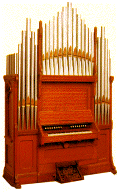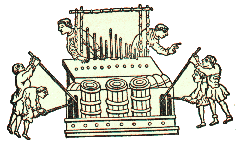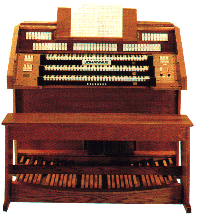|
Xtend
 Listen
Listen
 Jokes
Jokes
 Picture
Picture
 Evolution
Evolution
 Notes
Notes
 Dictionary
Dictionary
 Internet
Internet
 Projects
Projects
Relatives

Pan Flute

Harpsichord

Synthesizer
|
 
The Organ
Although it is mentioned in the
bible, the modern organ is not the same instrument as the biblical instrument,
but an ancient kind of Panpipes .
It is the biggest instrument, and the most
complicated one in terms of sound production .
It is the biggest instrument, and the most
complicated one in terms of sound production .
The organist plays it by beating the keyboards; yet the organ is a wind
instrument, for air passes through its many pipes thus producing sounds.
The longer the pipe - the lower the sound pitch .
The organist plays it by beating the keyboards; yet the organ is a wind
instrument, for air passes through its many pipes thus producing sounds.
The longer the pipe - the lower the sound pitch .
Each set of pipes (tubes) is built differently, and so produces a different
kind of sound (clarinet .
Each set of pipes (tubes) is built differently, and so produces a different
kind of sound (clarinet -like
sounds, trumpet -like
sounds, trumpet -like
sounds etc.) and is called a register. Special mechanisms assist the player
to shift registers and diversify his playing with different sorts of sounds.
The air pushed into the pipes is
now electrically generated, but in the past humans used to operate a bellows
to create the stream of air required to make the organ sounds. Organs were
commonplace mainly in large churches (cathedrals for example -like
sounds etc.) and is called a register. Special mechanisms assist the player
to shift registers and diversify his playing with different sorts of sounds.
The air pushed into the pipes is
now electrically generated, but in the past humans used to operate a bellows
to create the stream of air required to make the organ sounds. Organs were
commonplace mainly in large churches (cathedrals for example ),
since the price of building an organ was extremely high, and it later required
regular maintenance.
Throughout history, there were
portable organs (the portative organ ),
since the price of building an organ was extremely high, and it later required
regular maintenance.
Throughout history, there were
portable organs (the portative organ )
and fixed church organs (the "positive" )
and fixed church organs (the "positive" ).
In the 20th century, the electric organ ).
In the 20th century, the electric organ  was born, and became very popular in pop music
was born, and became very popular in pop music .
Among the famous works for organ
- the D minor Toccata and Fugue .
Among the famous works for organ
- the D minor Toccata and Fugue  by Bach
by Bach ,
who was one of the best organists of his time,
and wrote hundreds of pieces for this instrument; the work of Handel ,
who was one of the best organists of his time,
and wrote hundreds of pieces for this instrument; the work of Handel ,
with his organ concerti;
the organ sonatas by
Mendelssohn ,
with his organ concerti;
the organ sonatas by
Mendelssohn ;
and the fantasia Liszt ;
and the fantasia Liszt wrote on the letters of Bach's name (translated
into the notes B-A-C-H).
wrote on the letters of Bach's name (translated
into the notes B-A-C-H).
There were two Kinds of
Historical Organs:

Positive Organ
Stood in front of player
|
![Musician Angels [part] (1485) Hans Memling, Koninkijk Museum, Antwerp](../../pict/portaic.gif)
The portative Organ
Helded in player's hands
|
There are modern kinds of Organs today:
Electric
Organ

Compact Electric Organ

|
Composers

Bach

Handel

Mendelssohn

Liszt
History
 "The well designed
organ"
"The well designed
organ"
|